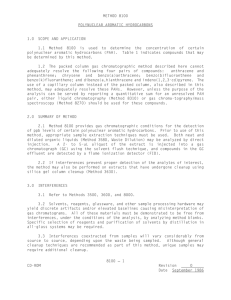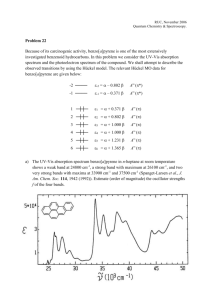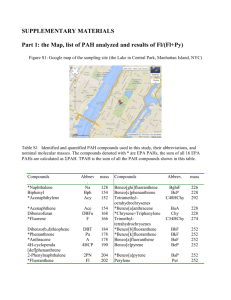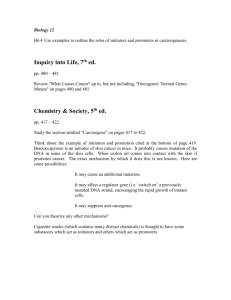METHOD 8310 POLYNUCLEAR AROMATIC HYDROCARBONS 1.0 SCOPE AND APPLICATION
advertisement
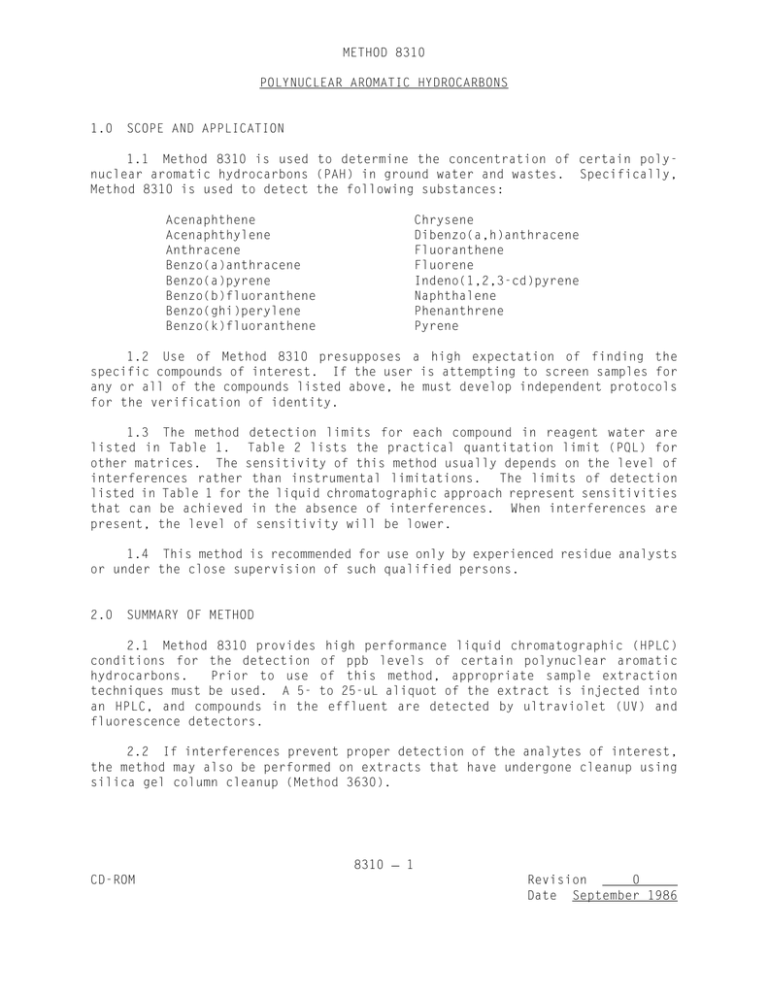
METHOD 8310 POLYNUCLEAR AROMATIC HYDROCARBONS 1.0 SCOPE AND APPLICATION 1.1 Method 8310 is used to determine the concentration of certain polynuclear aromatic hydrocarbons (PAH) in ground water and wastes. Specifically, Method 8310 is used to detect the following substances: Acenaphthene Acenaphthylene Anthracene Benzo(a)anthracene Benzo(a)pyrene Benzo(b)fluoranthene Benzo(ghi)perylene Benzo(k)fluoranthene Chrysene Dibenzo(a,h)anthracene Fluoranthene Fluorene Indeno(1,2,3-cd)pyrene Naphthalene Phenanthrene Pyrene 1.2 Use of Method 8310 presupposes a high expectation of finding the specific compounds of interest. If the user is attempting to screen samples for any or all of the compounds listed above, he must develop independent protocols for the verification of identity. 1.3 The method detection limits for each compound in reagent water are listed in Table 1. Table 2 lists the practical quantitation limit (PQL) for other matrices. The sensitivity of this method usually depends on the level of interferences rather than instrumental limitations. The limits of detection listed in Table 1 for the liquid chromatographic approach represent sensitivities that can be achieved in the absence of interferences. When interferences are present, the level of sensitivity will be lower. 1.4 This method is recommended for use only by experienced residue analysts or under the close supervision of such qualified persons. 2.0 SUMMARY OF METHOD 2.1 Method 8310 provides high performance liquid chromatographic (HPLC) conditions for the detection of ppb levels of certain polynuclear aromatic hydrocarbons. Prior to use of this method, appropriate sample extraction techniques must be used. A 5- to 25-uL aliquot of the extract is injected into an HPLC, and compounds in the effluent are detected by ultraviolet (UV) and fluorescence detectors. 2.2 If interferences prevent proper detection of the analytes of interest, the method may also be performed on extracts that have undergone cleanup using silica gel column cleanup (Method 3630). 8310 CD-ROM 1 Revision 0 Date September 1986 HIGH PERFORMANCE LIQUID CHROMATOGRAPHY OF PAHsa TABLE 1. Retention time (min) Compound Naphthalene Acenaphthylene Acenaphthene Fluorene Phenanthrene Anthracene Fluoranthrene Pyrene Benzo(a)anthracene Chrysene Benzo(b)fluoranthene Benzo(k)fluoranthene Benzo(a)pyrene Dibenzo(a,h)anthracene Benzo(ghi)perylene Indeno(1,2,3-cd)pyrene 16.6 18.5 20.5 21.2 22.1 23.4 24.5 25.4 28.5 29.3 31.6 32.9 33.9 35.7 36.3 37.4 Column capacity factor (k') 12.2 13.7 15.2 15.8 16.6 17.6 18.5 19.1 21.6 22.2 24.0 25.1 25.9 27.4 27.8 28.7 Method Detection limit (ug/L) UV Fluorescence 1.8 2.3 1.8 0.21 0.64 0.66 0.21 0.27 0.013 0.15 0.018 0.017 0.023 0.030 0.076 0.043 a HPLC conditions: Reverse phase HC-ODS Sil-X, 5 micron particle size, in a 250-mm x 2.6-mm I.D. stainless steel column. Isocratic elution for 5 min using acetonitrile/water (4:6)(v/v), then linear gradient elution to 100% acetonitrile over 25 min at 0.5 mL/min flow rate. If columns having other internal diameters are used, the flow rate should be adjusted to maintain a linear velocity of 2 mm/sec. TABLE 2. DETERMINATION OF PRACTICAL QUANTITATION LIMITS (PQL) FOR VARIOUS MATRICESa Factorb Matrix Ground water Low-level soil by sonication with GPC cleanup High-level soil and sludges by sonication Non-water miscible waste 10 670 10,000 100,000 a Sample PQLs are highly matrix-dependent. The PQLs listed herein are provided for guidance and may not always be achievable. b PQL = [Method Detection Limit (Table 1) X [Factor (Table 2)]. aqueous samples, the factor is on a wet-weight basis. 8310 CD-ROM For non- 2 Revision 0 Date September 1986 3.0 INTERFERENCES 3.1 Solvents, reagents, glassware, and other sample processing hardware may yield discrete artifacts and/or elevated baselines, causing misinterpretation of the chromatograms. All of these materials must be demonstrated to be free from interferences, under the conditions of the analysis, by running method blanks. Specific selection of reagents and purification of solvents by distillation in all-glass systems may be required. 3.2 Interferences coextracted from the samples will vary considerably from source to source. Although a general cleanup technique is provided as part of this method, individual samples may require additional cleanup approaches to achieve the sensitivities stated in Table 1. 3.3 The chromatographic conditions described allow for a unique resolution of the specific PAH compounds covered by this method. Other PAH compounds, in addition to matrix artifacts, may interfere. 4.0 APPARATUS AND MATERIALS 4.1 Kuderna-Danish (K-D) apparatus: 4.1.1 Concentrator tube: 10-mL, graduated (Kontes K-570050-1025 or equivalent). Ground-glass stopper is used to prevent evaporation of extracts. 4.1.2 Evaporation flask: 500-mL (Kontes K-570001-500 or equivalent). Attach to concentrator tube with springs. 4.1.3 Snyder column: equivalent). 4.1.4 Snyder equivalent). 4.2 Boiling chips: carbide or equivalent). column: Three-ball macro (Kontes K-503000-0121 or Two-ball micro (Kontes K-569001-0219 or Solvent extracted, approximately 10/40 mesh (silicon 4.3 Water bath: Heated, with concentric ring cover, capable of temperature control (+5EC). The bath should be used in a hood. 5-mL. 4.4 Syringe: 4.5 High pressure syringes. 4.6 HPLC apparatus: 4.6.1 Gradient pumping system: Constant flow. 4.6.2 Reverse phase column: HC-ODS Sil-X, 5-micron particle size diameter, in a 250-mm x 2.6-mm I.D. stainless steel column (Perkin Elmer No. 089-0716 or equivalent). 8310 CD-ROM 3 Revision 0 Date September 1986 4.6.3 Detectors: Fluorescence and/or UV detectors may be used. 4.6.3.1 Fluorescence detector: For excitation at 280-nm and emission greater than 389-nm cutoff (Corning 3-75 or equivalent). Fluorometers should have dispersive optics for excitation and can utilize either filter or dispersive optics at the emission detector. 4.6.3.2 UV detector. detector: 254-nm, coupled to the fluorescence 4.6.4 Strip-chart recorder: compatible with detectors. A data system for measuring peak areas and retention times is recommended. 4.7 5.0 Volumetric flasks: 10-, 50-, and 100-mL. REAGENTS Reagent water is defined as water in which an 5.1 Reagent water: interferent is not observed at the method detection limit of the compounds of interest. HPLC quality, distilled in glass. 5.2 Acetonitrile: 5.3 Stock standard solutions: 5.3.1 Prepare stock standard solutions at a concentration of 1.00 ug/uL by dissolving 0.0100 g of assayed reference material in acetonitrile and diluting to volume in a 10-mL volumetric flask. Larger volumes can be used at the convenience of the analyst. When compound purity is assayed to be 96% or greater, the weight can be used without correction to calculate the concentration of the stock standard. Commercially prepared stock standards can be used at any concentration if they are certified by the manufacturer or by an independent source. 5.3.2 Transfer the stock standard solutions into Teflon-sealed screwcap bottles. Store at 4EC and protect from light. Stock standards should be checked frequently for signs of degradation or evaporation, especially just prior to preparing calibration standards from them. 5.3.3 Stock standard solutions must be replaced after one year, or sooner if comparison with check standards indicates a problem. Calibration standards at a minimum of five 5.4 Calibration standards: concentration levels should be prepared through dilution of the stock standards with acetonitrile. One of the concentration levels should be at a concentration near, but above, the method detection limit. The remaining concentration levels should correspond to the expected range of concentrations found in real samples or should define the working range of the HPLC. Calibration standards must be replaced after six months, or sooner if comparison with check standards indicates a problem. 8310 CD-ROM 4 Revision 0 Date September 1986 5.5 Internal standards (if internal standard calibration is used): To use this approach, the analyst must select one or more internal standards that are similar in analytical behavior to the compounds of interest. The analyst must further demonstrate that the measurement of the internal standard is not affected by method or matrix interferences. Because of these limitations, no internal standard can be suggested that is applicable to all samples. 5.5.1 Prepare calibration standards at a minimum of five concentration levels for each analyte as described in Paragraph 5.4. 5.5.2 To each calibration standard, add a known constant amount of one or more internal standards, and dilute to volume with acetonitrile. 5.5.3 Analyze each calibration standard according to Section 7.0. 5.6 Surrogate standards: The analyst should monitor the performance of the extraction, cleanup (if necessary), and analytical system and the effectiveness of the method in dealing with each sample matrix by spiking each sample, standard, and reagent water blank with one or two surrogates (e.g., decafluorobiphenyl or other PAHs not expected to be present in the sample) recommended to encompass the range of the temperature program used in this method. Deuterated analogs of analytes should not be used as surrogates for HPLC analysis due to coelution problems. 6.0 SAMPLE COLLECTION, PRESERVATION, AND HANDLING 6.1 See the introductory material to this chapter, Organic Analytes, Section 4.1. Extracts must be stored under refrigeration and must be analyzed within 40 days of extraction. 7.0 PROCEDURE 7.1 Extraction: 7.1.1 Refer to Chapter Two for guidance on choosing the appropriate extraction procedure. In general, water samples are extracted at a neutral pH with methylene chloride, using either Method 3510 or 3520. Solid samples are extracted using either Method 3540 or 3550. To achieve maximum sensitivity with this method, the extract must be concentrated to 1 mL. 7.1.2 Prior to HPLC analysis, the extraction solvent must be exchanged to acetonitrile. The exchange is performed during the K-D procedures listed in all of the extraction methods. The exchange is performed as follows. 7.1.2.1 Following K-D of the methylene chloride extract to 1 mL using the macro-Snyder column, allow the apparatus to cool and drain for at least 10 min. 8310 CD-ROM 5 Revision 0 Date September 1986 7.1.2.2 Increase the temperature of the hot water bath to 95100EC. Momentarily remove the Snyder column, add 4 mL of acetonitrile, a new boiling chip, and attach a two-ball micro-Snyder column. Concentrate the extract using 1 mL of acetonitrile to prewet the Snyder column. Place the K-D apparatus on the water bath so that the concentrator tube is partially immersed in the hot water. Adjust the vertical position of the apparatus and the water temperature, as required, to complete concentration in 15-20 min. At the proper rate of distillation the balls of the column will actively chatter, but the chambers will not flood. When the apparent volume of liquid reaches 0.5 mL, remove the K-D apparatus and allow it to drain and cool for at least 10 min. 7.1.2.3 When the apparatus is cool, remove the micro-Snyder column and rinse its lower joint into the concentrator tube with about 0.2 mL of acetonitrile. A 5-mL syringe is recommended for this operation. Adjust the extract volume to 1.0 mL. Stopper the concentrator tube and store refrigerated at 4EC, if further processing will not be performed immediately. If the extract will be stored longer than two days, it should be transferred to a Teflon-sealed screw-cap vial. Proceed with HPLC analysis if further cleanup is not required. 7.2 HPLC conditions (Recommended): 7.2.1 Using the column described in Paragraph 4.6.2: Isocratic elution for 5 min using acetonitrile/water (4:6)(v/v), then linear gradient elution to 100% acetonitrile over 25 min at 0.5 mL/min flow rate. If columns having other internal diameters are used, the flow rate should be adjusted to maintain a linear velocity of 2 mm/sec. 7.3 Calibration: 7.3.1 Refer to Method 8000 for proper calibration procedures. The procedure of internal or external standard calibration may be used. Use Table 1 and especially Table 2 for guidance on selecting the lowest point on the calibration curve. 7.3.2 Assemble the necessary HPLC apparatus and establish operating parameters equivalent to those indicated in Section 7.2.1. By injecting calibration standards, establish the sensitivity limit of the detectors and the linear range of the analytical systems for each compound. 7.3.3 Before using any cleanup procedure, the analyst should process a series of calibration standards through the procedure to confirm elution patterns and the absence of interferences from the reagents. 7.4 HPLC analysis: 7.4.1 Table 1 summarizes the estimate retention times of PAHs determinable by this method. Figure 1 is an example of the separation achievable using the conditions given in Paragraph 7.2.1. 8310 CD-ROM 6 Revision 0 Date September 1986 8310 CD-ROM 7 Revision 0 Date September 1986 7.4.2 If internal standard calibration is to be performed, add 10 uL of internal standard to the sample prior to injection. Inject 2-5 uL of the sample extract with a high-pressure syringe or sample injection loop. Record the volume injected to the nearest 0.1 uL, and the resulting peak size, in area units or peak heights. Re-equilibrate the HPLC column at the initial gradient conditions for at least 10 min between injections. 7.4.3 Using either the internal or external calibration procedure (Method 8000), determine the identity and quantity of each component peak in the sample chromatogram which corresponds to the compounds used for calibration purposes. See Section 7.8 of Method 8000 for calculation equations. 7.4.4 If the peak area exceeds the linear range of the system, the extract and reanalyze. dilute 7.4.5 If the peak area measurement is prevented by the presence of interferences, further cleanup is required. 7.5 Cleanup: 7.5.1 Cleanup of the acetonitrile extract takes place using Method 3630 (Silica Gel Cleanup). Specific instructions for cleanup of the extract for PAHs is given in Section 7.1 of Method 3630. 7.5.2 Following cleanup, analyze the samples using HPLC as described in Section 7.4. 8.0 QUALITY CONTROL 8.1 Refer to Chapter One for specific quality control procedures. Quality control to validate sample extraction is covered in Method 3500 and in the extraction method used. If extract cleanup was performed, follow the QC in Method 3600 and in the specific cleanup method. 8.2 Mandatory quality control to validate the HPLC system operation is found in Method 8000, Section 8.6. 8.2.1 The quality control check sample concentrate (Method 8000, Section 8.6) should contain each analyte at the following concentrations in acetonitrile: naphthalene, 100 ug/mL; acenaphthylene, 100 ug/mL; acenaphthene, 100 ug/mL; fluorene, 100 ug/mL; phenanthrene, 100 ug/mL; anthracene, 100 ug/mL; benzo(k)fluoranthene, 5 ug/mL; and any other PAH at 10 ug/mL. 8.2.2 Table 3 indicates the calibration and QC acceptance criteria for this method. Table 4 gives method accuracy and precision as functions of concentration for the analytes of interest. The contents of both Tables should be used to evaluate a laboratory's ability to perform and generate acceptable data by this method. 8310 CD-ROM 8 Revision 0 Date September 1986 8.3 Calculate surrogate standard recovery on all samples, blanks, and spikes. Determine if the recovery is within limits (limits established by performing QC procedures outlined in Method 8000, Section 8.10). 8.3.1 required. If recovery is not within limits, the following procedures are . Check to be sure there are no errors in calculations, surrogate solutions and internal standards. Also, check instrument performance. . Recalculate the data and/or reanalyze the extract if any of the above checks reveal a problem. . Reextract and reanalyze the sample if none of the above are a problem or flag the data as "estimated concentration." 9.0 METHOD PERFORMANCE 9.1 The method was tested by 16 laboratories using reagent water, drinking water, surface water, and three industrial wastewaters spiked at six concentrations over the range 0.1 to 425 ug/L. Single operator precision, overall precision, and method accuracy were found to be directly related to the concentration of the analyte and essentially independent of the sample matrix. Linear equations to describe these relationships are presented in Table 4. 9.2 This method has been tested for linearity of spike recovery from reagent water and has been demonstrated to be applicable over the concentration range from 8 x MDL to 800 x MDL with the following exception: benzo(ghi)perylene recovery at 80 x and 800 x MDL were low (35% and 45%, respectively). 9.3 The accuracy and precision obtained will be determined by the sample matrix, sample-preparation technique, and calibration procedures used. 10.0 REFERENCES 1. "Development and Application of Test Procedures for Specific Organic Toxic Substances in Wastewaters, Category 9 - PAHs," Report for EPA Contract 68-032624 (in preparation). 2. Sauter, A.D., L.D. Betowski, T.R. Smith, V.A. Strickler, R.G. Beimer, B.N. Colby, and J.E. Wilkinson, "Fused Silica Capillary Column GC/MS for the Analysis of Priority Pollutants," Journal of HRC&CC 4, 366-384, 1981. 3. "Determination of Polynuclear Aromatic Hydrocarbons in Industrial and Municipal Wastewaters," EPA-600/4-82-025, U.S. Environmental Protection Agency, Environmental Monitoring and Support Laboratory, Cincinnati, Ohio 45268, September 1982. 8310 CD-ROM 9 Revision 0 Date September 1986 4. Burke, J.A. "Gas Chromatography for Pesticide Residue Analysis; Some Practical Aspects," Journal of the Association of Official Analytical Chemists, 48, 1037, 1965. 5. "EPA Method Validation Study 20, Method 610 (Polynuclear Hydrocarbons)," Report for EPA Contract 68-03-2624 (in preparation). Aromatic 6. U.S. EPA 40 CFR Part 136, "Guidelines Establishing Test Procedures for the Analysis of Pollutants Under the Clean Water Act; Final Rule and Interim Final Rule and Proposed Rule," October 26, 1984. 7. Provost, L.P. and R.S. Elder, "Interpretation of Percent Recovery Data," American Laboratory, 15, pp. 58-63, 1983. 8310 CD-ROM 10 Revision 0 Date September 1986 TABLE 3. QC ACCEPTANCE CRITERIAa Parameter Acenaphthene Acenaphthylene Anthracene Benzo(a)anthracene Benzo(a)pyrene Benzo(b)fluoranthene Benzo(ghi)perylene Benzo(k)fluoranthene Chrysene Dibenzo(a,h)anthracene Fluoranthene Fluorene Indeno(1,2,3-cd)pyrene Naphthalene Phenanthrene Pyrene Test conc. (ug/L) Limit for s (ug/L) 100 100 100 10 10 10 10 5 10 10 10 100 10 100 100 10 40.3 45.1 28.7 4.0 4.0 3.1 2.3 2.5 4.2 2.0 3.0 43.0 3.0 40.7 37.7 3.4 Range for x (ug/L) D-105.7 22.1-112.1 11.2-112.3 3.1-11.6 0.2-11.0 1.8-13.8 D-10.7 D-7.0 D-17.5 0.3-10.0 2.7-11.1 D-119 1.2-10.0 21.5-100.0 8.4-133.7 1.4-12.1 Range p, ps (%) D-124 D-139 D-126 12-135 D-128 6-150 D-116 D-159 D-199 D-110 14-123 D-142 D-116 D-122 D-155 D-140 s = Standard deviation of four recovery measurements, in ug/L. x = Average recovery for four recovery measurements, in ug/L. p, ps = Percent recovery measured. D = Detected; result must be greater than zero. a Criteria from 40 CFR Part 136 for Method 610. These criteria are based directly upon the method performance data in Table 3. Where necessary, the limits for recovery have been broadened to assure applicability of the limits to concentrations below those used to develop Table 3. 8310 CD-ROM 11 Revision 0 Date September 1986 METHOD ACCURACY AND PRECISION AS FUNCTIONS OF CONCENTRATIONa Parameter Acenaphthene Acenaphthylene Anthracene Benzo(a)anthracene Benzo(a)pyrene Benzo(b)fluoranthene Benzo(ghi)perylene Benzo(k)fluoranthene Chrysene Dibenzo(a,h)anthracene Fluoranthene Fluorene Indeno(1,2,3-cd)pyrene Naphthalene Phenanthrene Pyrene x' Accuracy, as recovery, x' (ug/L) 0.52C+0.54 0.69C-1.89 0.63C-1.26 0.73C+0.05 0.56C+0.01 0.78C+0.01 0.44C+0.30 0.59C+0.00 0.77C-0.18 0.41C-0.11 0.68C+0.07 0.56C-0.52 0.54C+0.06 0.57C-0.70 0.72C-0.95 0.69C-0.12 Single analyst precision, sr' (ug/L) 0.39x+0.76 0.36x+0.29 0.23x+1.16 0.28x+0.04 0.38x-0.01 0.21x+0.01 0.25x+0.04 0.44x-0.00 0.32x-0.18 0.24x+0.02 0.22x+0.06 0.44x-1.12 0.29x+0.02 0.39x-0.18 0.29x+0.05 0.25x+0.14 = Expected recovery for one or more measurements containing a concentration of C, in ug/L. Overall precision, S' (ug/L) 0.53x+1.32 0.42x+0.52 0.41x+0.45 0.34x+0.02 0.53x-0.01 0.38x-0.00 0.58x+0.10 0.69x+0.10 0.66x-0.22 0.45x+0.03 0.32x+0.03 0.63x-0.65 0.42x+0.01 0.41x+0.74 0.47x-0.25 0.42x-0.00 of a sample sr' = Expected single analyst standard deviation of measurements at an average concentration of x, in ug/L. S' = Expected interlaboratory standard deviation of measurements at an average concentration found of x, in ug/L. C = True value for the concentration, in ug/L. x = Average recovery found for measurements of samples containing a concentration of C, in ug/L. 8310 CD-ROM 12 Revision 0 Date September 1986 8310 CD-ROM 13 Revision 0 Date September 1986
